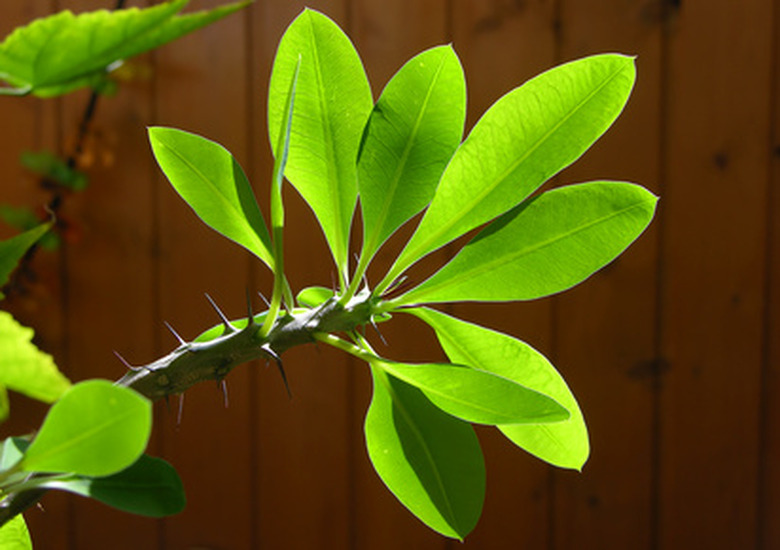Thorny Tropical Plants
Thorny tropical plants are survivors, so they might be a good choice for gardeners planting in tough sites, or for those who seek the ultimate low-maintenance landscapes. Useful as specimen plants in dry gardens, the plants feature built-in protection, which allows them to withstand drought and discourage foraging animals and insects.
Geography
Tropical plants originate in areas designated as tropical–that fall in the zone between the tropic of Capricorn and the tropic of Cancer–bisected by the Equator. The region encompasses different types of climates. Some tropical regions receive abundant rainfall and have lush forested areas. Other tropical regions are dry and arid. Rain forests in Colombia and Brazil are tropical, as are some desert regions of Madagascar and Venezuela.
- Thorny tropical plants are survivors, so they might be a good choice for gardeners planting in tough sites, or for those who seek the ultimate low-maintenance landscapes.
- Useful as specimen plants in dry gardens, the plants feature built-in protection, which allows them to withstand drought and discourage foraging animals and insects.
Significance
Tough, thorny plants provide biodiversity in often-desolate locations. The existence of tropical thorny plants is critical to animals that live in arid harsh environments—they provide shelter and food to animals.
Benefits
Thorns protect a plant from animals foraging in the area. In dry areas, plants must build up water reserves, in order to survive drought. Without armature, water-filled trunks or limbs would succumb quickly to thirsty creatures. Some plants such as the tree Chorisia speciosa actually store water in the large spines themselves.
Types
Crown of thorns (Euphorbia milii) is a succulent with fierce-looking spines all over its limbs. The plant has upright, shrubby growth and survives hot sunny conditions. Bright red flowers bloom on branch tips when the plant receives enough moisture. Gardeners can clip off a segment of the Euphorbia milii, set the section aside in the shade for a few days, then, plant the segment in a pot to grow a new plant.
- Tough, thorny plants provide biodiversity in often-desolate locations.
- Crown of thorns (Euphorbia milii) is a succulent with fierce-looking spines all over its limbs.
Chorisia speciosa is a large tree, native to Brazil and other tropical regions in South America. It has a nickname of "drunken tree" or "palo borracho" due to the swollen bulging trunk where it stores its water reserves against drought. Young trees have green trunks capable of photosynthesis, as the tree can lose leaves when drought-stressed. White flowers appear at the tips of the spine-covered branches, followed by long black pods that contain black seeds encased in a fluffy cotton-like material.
Different species of Cacti and thorny shrubs make up dry tropical thorn forests, which grow next to more lush forests in Madagascar, or thorn scrubs which appear in arid regions next to deserts in Mexico and other locations.
Considerations
Not all thorny plants, such as crown of thorns, are as fierce as they look, but others, such as opuntia cactus, have sharp spines. Using tropical thorny plants in gardens can be problematic for families with children. Avoiding planting thorny plants of any kind around swimming pools or play area can help avoid accidents. Chorisia speciosa looks like a Dr. Seuss type plant when young–but it grows up to 60 feet in height, and the trunk can bulge out, taking over small yards.
- Chorisia speciosa is a large tree, native to Brazil and other tropical regions in South America.
- Chorisia speciosa looks like a Dr. Seuss type plant when young–but it grows up to 60 feet in height, and the trunk can bulge out, taking over small yards.
